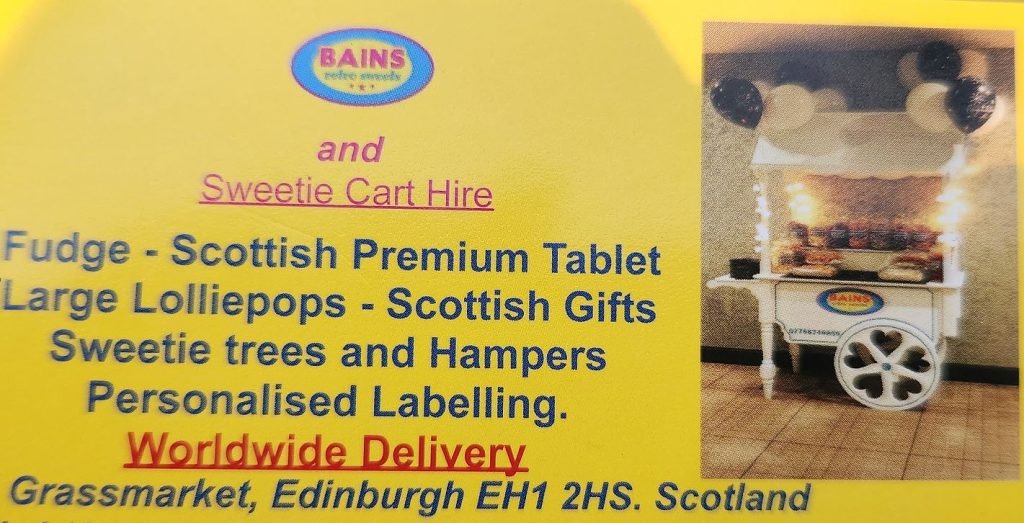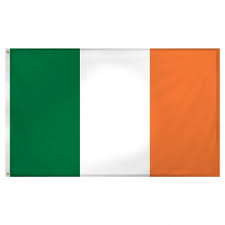
In August and September I traveled throughout Great Britain. This was a heritage trip and not designed as a genealogy trip. What’s the difference? A heritage trip is a visit to an area in which your family once resided but while there you aren’t looking for the old homestead or farm. Rather, you are just getting a feel for what the area is like. A genealogy trip is when you are actively researching records for an ancestor.
To be honest, I couldn’t help but combine the two. I did stop at libraries and genealogical societies in a few places to see if I could find anything that wasn’t already online. No luck! I also just showed up at several locations where I knew that my husband or my ancestors had once lived to ask about various surnames.
The picture above is of Bains Sweet Shop in Edinburgh, Scotland. Our hotel happened to be next door. While exploring the city I was stunned to see the sign – yes, I have a sweet tooth but it was the owner’s name that struck me. I am a Bains/Baines/Baynes and my distant cousin Vickie had asked me before I left to see if I could get any information on that wonderful Quaker line.
The Bains are often in my thoughts as I put in a fireplace in my home two years ago. Unknowingly, I was drawn to a type of rock to use and when it arrived at my home to be installed, I was surprised to discover I had selected rock quarried from Bucks County, Pennsylvania. That’s where my 7th great grandmother, Elinor “Ellin” had emigrated to. Her parents, Mathew and Margaret Hatton Baines/Bean had died at sea. I’ve wondered if Ellin had a stone fireplace similar to mine.
I didn’t expect to actually meet a Bains on my travels but I did. Mr. Bain was not into genealogy and had no idea how we could be connected but he did know that his family had been in Scotland for hundreds of years. He jokingly told me to research his line and let him know if I find we are related. Kindly, he gave my husband and I free samples of his delicious candy that he makes himself.
My husband was also in for a surprise. We had decided to visit a site that was once a monastery in Ireland. The tour guide mentioned Brian Boru, of who I am descended. The guide gave some incorrect information about the University of Notre Dame so after the tour ended, I approached him to let him know privately that the school is not known as the Fighting Irish because they come from Irish fighters but because they had once taken on the Ku Klux Klan when that white supremacist organization tried to instill their racist views on South Bend, Indiana.
The tour guide said he did know the real reason but his story was much more entertaining (Sigh). He then mentioned he had noticed I was very interested in what he had to say about Brian Boru. I told him I was a descendant and he asked me if I was an O’Brien. I told him no, but that my husband’s third great grandmother was Mary “Molly” O’Brien from Limerick. In sharing our genealogies, turns out he was my husband’s third cousin. He also claimed to be a descendant of Brian Boru meaning, my husband is likely, also. This isn’t the first time that my husband and I have shared an ancestor but it was the strangest way I’ve ever gotten a hint that we might have. Definitely, more research is needed. What struck me as odd, though, was that in May I had sought out the location of Molly’s grave in Chicago and discovered there was no stone. Since then, I submitted an article for publication in an Irish American newsletter about Mary and her unusual agreement with her husband. Mary was Roman Catholic, her husband was Protestant. Back in the 1850s they agree to maintain both faiths in their household. I’ve blogged about their decision previously but thought it should be published somewhere for future generations. I had just emailed the article off the day before we left for the trip and wasn’t thinking much more about Molly until this strange connection occurred.
Makes you wonder, doesn’t it?!
Next week I’ll be heading off to the 36th International Congress of Genealogical and Heraldic Sciences in Boston so I won’t be blogging next weekend. See you the following week.

